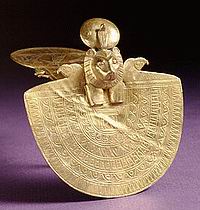The term “Aegis” was related to a religious figure in Egyptian mythology. It has been interpreted differently in many cultures, thus its meaning varies from culture to culture.

Ancient Egypt Aegis can be defined as a large broad collar-like necklace surmounted by the head of a divinity. On few occasions, the Egyptian goddess Bastet has been portrayed with Aegis in one hand and ceremonial sistrum in another. For the goddess Bastet, aegis means a collar or gorget worn along with a lioness head. signifying Egypt. As an attribute carried by goddess Bastet, the aegis may be a symbol of the divinity herself. The cult goddess of Egypt, Isis was also depicted wearing aegis, as a large broad collar. During the ancient period, Aegis was also associated with shield- shaped amulet as a symbol of protection.
Aegis- Symbol of Protection and Authority
In ancient Egypt, Aegis can be defined as a large collar that was worn by religious figures. Aegis was also associated with a small cloak made from goatskin in a mythological narration of Zeus and Athena. The cloak was used for protection and authority. The aegis that belonged to Athena was depicted with a border of snakes along with Medusa’s head placed at the center.
Aegis has also been described to mean a belt made from goatskin worn with the protective shield. This shield was shaped as an amulet. And this shield-shaped amulet was worn over the shoulders, breast and left arm for protection. A hunting bag like a garment made from goatskin was also used as Aegis. The protective shield and the garment at times were stitched together. At times, the garment and the protective shield were stitched together. In Egyptian Mythology, wearing of the Aegis was a symbol of protection, authority or even support of the deity. The Book of the Dead says that on the day of burial, the Aegis must be placed on the neck of the deceased for protection.
